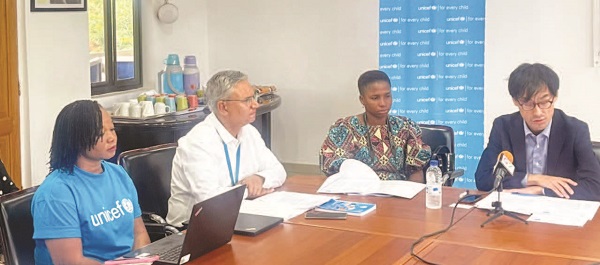The Japanese government is spending US$1,001,666 on the implementation of a project to ensure continuous delivery of essential services to border communities in the Upper East and Upper West regions at risk of a spill-over of the ongoing Sahel conflict.
The project dubbed, ‘Sahel Spillover Resilience Building,’ was undertaken in collaboration with the United Nations Children’s Fund (UNICEF) in Ghana.
It is focused on health and nutrition; water, sanitation and hygiene ((WASH) education and social behavioural change.
So far, communities including Sapeliga, Googo, Banse and Yarigungu which became hosts to persons fleeing the conflict had benefitted from enhanced capacity of social services.
Discussing the need for the project during an engagement with officials of UNICEF in Ghana at Tamale on Thursday, Sonoda Shohei, First Secretary of the Japanese Embassy in Ghana, said support for the project was motivated by growing concern about the direct and indirect effect of the spillover deterioration of security and
destabilisation in the Central Sahel on the borderline communities in the country.
He indicated that the spillover could disrupt previous efforts and progress Ghana had made in providing basic services to the people in those areas.
“As a way of safeguarding this progress based on the principle of human security and the commitment to achieve the goals of the Universal Health Coverage (UHC), it was important for Japan to support the project in order to strengthen existing support structures to continue providing these basic services,” Mr Shohei noted.
Additionally, he said, the project also aligned with Japan’s commitment to strengthen development, peace and security in Africa.
As Ghana’s development partner, Japan, he stated, was ready to commit more resources towards the extension of the project to other districts along the borderline to reduce the impact of the spill-over on residents.
Mr Bhanu Pathak, Chief Field Officer, UNICEF Tamale Office, said since January 2020, about 221 communities had been exposed to violent attacks and clashes which had affected 17 schools and three health facilities.
He noted that 62 communities in the two regions, which were assessed by UNICEF showed they were vulnerable to violent attacks which would exceed limited access to basic services, such as health and safe water and impact negatively on education.
With the violence in the Sahel region on the rise, he reiterated the need to support the communities with strategies to increase their resilience to lower the severity of the impact on them.
He said the project was designed to build the resilience of government’s systems to ensure the continuous provision of essential services to communities at risk of a spillover.
The project, he explained, was also to empower communities, especially women and children with knowledge and information on the need to continually maintain access to services that promote the wellbeing of their children and families.
Among other activities, Mr Pathak said the project enabled community-driven outreach capacity across health facilities in targeted areas, construction of water supply systems at Paga and Sirigu in the Upper East Region and Hamile in the Upper West Region, training of teachers and Ghana Education Service (GES) personnel.
He noted that community leaders and stakeholders were also engaged on emergency preparedness to support spillover activities.
FROM CLAUDE NYARKO ADAMS, TAMALE

